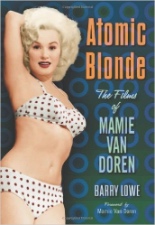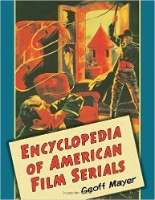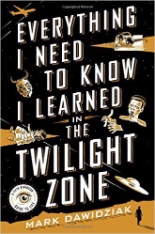 Getting a nightly fix of The Twilight Zone in a syndicated run one summer in the 1980s, I was taught a couple of things: Rod Serling was a frickin’ genius, and not all black-and-white TV is boring. According to TV critic Mark Dawidziak, many more lessons await imparting, which he has detailed in Everything I Need to Know I Learned in the Twilight Zone: A Fifth-Dimension Guide to Life, a “heartfelt tribute … wrapped in a self-help book.” Here, Dawidziak has taken 50 common-sense life lessons — such as “Never cry wolf” and “If something looks too good to be true, it probably is” — and discusses them in relation to key TZ episodes (even the one with Talking Tina). While the book is not an episode guide, each chapter could stand alone as a fine essay on one aspect of the game-changing series. Fully illustrated with stills from the shows in question and including “Guest Lessons” from the likes of Leonard Maltin and Mel Brooks, Dawidziak’s syllabus is infinitely more relatable than the likes of Zig Ziglar, but you’d better already be a hardcore TZ fan to gain any value.
Getting a nightly fix of The Twilight Zone in a syndicated run one summer in the 1980s, I was taught a couple of things: Rod Serling was a frickin’ genius, and not all black-and-white TV is boring. According to TV critic Mark Dawidziak, many more lessons await imparting, which he has detailed in Everything I Need to Know I Learned in the Twilight Zone: A Fifth-Dimension Guide to Life, a “heartfelt tribute … wrapped in a self-help book.” Here, Dawidziak has taken 50 common-sense life lessons — such as “Never cry wolf” and “If something looks too good to be true, it probably is” — and discusses them in relation to key TZ episodes (even the one with Talking Tina). While the book is not an episode guide, each chapter could stand alone as a fine essay on one aspect of the game-changing series. Fully illustrated with stills from the shows in question and including “Guest Lessons” from the likes of Leonard Maltin and Mel Brooks, Dawidziak’s syllabus is infinitely more relatable than the likes of Zig Ziglar, but you’d better already be a hardcore TZ fan to gain any value.
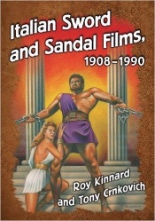 By the power of Zeus, Italian Sword and Sandal Films, 1908-1990 is not the definitive book I wanted it to be, mostly because so little of it required actual writing on the part of co-authors Roy Kinnard and Tony Crnkovich. Published by McFarland & Company, the trade paperback does cover what its title promises, with films of the peplum genre arranged alphabetically from Adventurer of Tortuga to Zorro the Rebel, but said coverage is largely rendered irrelevant by the existence of the IMDb, because we get a full list of the cast and crew. Comments from Kinnard and Crnkovich, unfortunately, are limited to a sentence or two, except in the rare case of a game-changer like 1958’s Hercules. Otherwise, their contribution to each entry is scant; for example, for Charge of the Black Lancers, they write in total, “It’s the Poles vs. the Tartars in this action drama, co-produced by Italy’s Royal Film, France’s France-Cinéma Productions, and Yugoslavia’s C.F.S. Košutnjak.” Gripping, no? Although illustrations are bountiful, Italian Sword and Sandal Films is more of a list than a book. I suppose if the apocalypse wipes out the internet, it may serve more purpose.
By the power of Zeus, Italian Sword and Sandal Films, 1908-1990 is not the definitive book I wanted it to be, mostly because so little of it required actual writing on the part of co-authors Roy Kinnard and Tony Crnkovich. Published by McFarland & Company, the trade paperback does cover what its title promises, with films of the peplum genre arranged alphabetically from Adventurer of Tortuga to Zorro the Rebel, but said coverage is largely rendered irrelevant by the existence of the IMDb, because we get a full list of the cast and crew. Comments from Kinnard and Crnkovich, unfortunately, are limited to a sentence or two, except in the rare case of a game-changer like 1958’s Hercules. Otherwise, their contribution to each entry is scant; for example, for Charge of the Black Lancers, they write in total, “It’s the Poles vs. the Tartars in this action drama, co-produced by Italy’s Royal Film, France’s France-Cinéma Productions, and Yugoslavia’s C.F.S. Košutnjak.” Gripping, no? Although illustrations are bountiful, Italian Sword and Sandal Films is more of a list than a book. I suppose if the apocalypse wipes out the internet, it may serve more purpose.
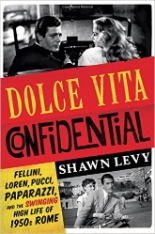 I want to get lost in Rat Pack Confidential author Shawn Levy’s latest book. Not in the sense of perusing its pages, which I’ve already done, but actually retreating to the world it depicts. Pending the creation of the time machine, I was born too late. The next best thing is the book, Dolce Vita Confidential: Fellini, Loren, Pucci, Paparazzi, and the Swinging High Life of 1950s Rome, and while not exclusively about movies and the men and women who made them (hence the Pucci, as in kaleidoscopic fashion maven Emilio), the cinema arguably did more than high fashion to make the Italian capital a cultural touchstone around the postwar globe; Anita Ekberg’s fountain-cavorting sure saw to that. Part history, part travelogue, all intoxicating, Levy’s multinarrative work vividly recalls a jet-set splendor that, while never can be replicated, at least can be revisited through the film classics that have visually bottled that feeling forever. Or we could always throw an orgy. —Rod Lott
I want to get lost in Rat Pack Confidential author Shawn Levy’s latest book. Not in the sense of perusing its pages, which I’ve already done, but actually retreating to the world it depicts. Pending the creation of the time machine, I was born too late. The next best thing is the book, Dolce Vita Confidential: Fellini, Loren, Pucci, Paparazzi, and the Swinging High Life of 1950s Rome, and while not exclusively about movies and the men and women who made them (hence the Pucci, as in kaleidoscopic fashion maven Emilio), the cinema arguably did more than high fashion to make the Italian capital a cultural touchstone around the postwar globe; Anita Ekberg’s fountain-cavorting sure saw to that. Part history, part travelogue, all intoxicating, Levy’s multinarrative work vividly recalls a jet-set splendor that, while never can be replicated, at least can be revisited through the film classics that have visually bottled that feeling forever. Or we could always throw an orgy. —Rod Lott


